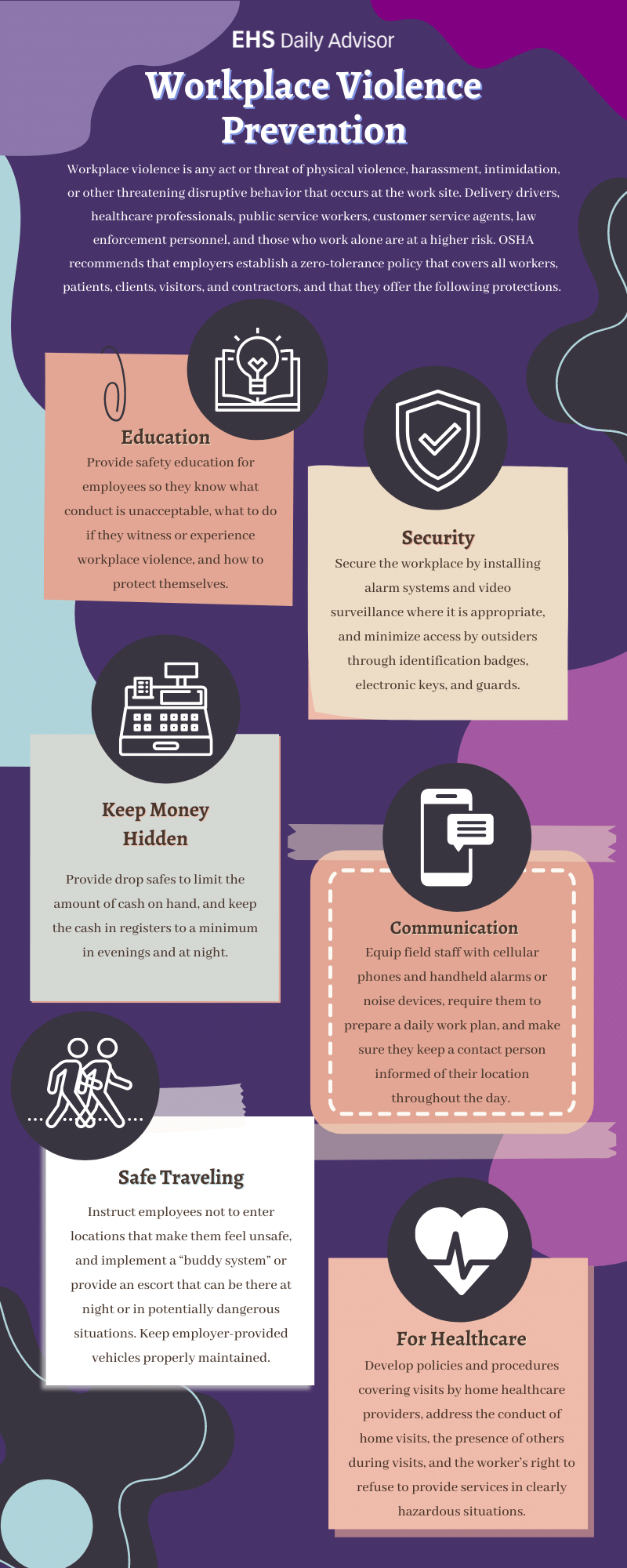The Role of Staff Member Training and Awareness in Enhancing Office Physical Violence Avoidance Initiatives Across Numerous Industries
The assimilation of employee training and recognition right into office violence prevention efforts is significantly acknowledged as a fundamental element of business security across varied sectors. By implementing targeted training programs, organizations can successfully equip their labor force to identify and resolve prospective risks prior to they intensify. However, the effectiveness of these efforts commonly depends upon numerous vital factors that vary by market, raising vital concerns concerning the flexibility of training methods and their real-world effect. Understanding these nuances may reveal methods that can significantly improve safety and security procedures and employee confidence in risky settings.
Importance of Educating Programs
In today's dynamic work setting, the value of training programs can not be overemphasized, specifically in the context of workplace physical violence prevention. These programs act as a foundational aspect in cultivating a protected and safe workplace society. By gearing up workers with the understanding and abilities needed to identify, alleviate, and react to potential risks, companies can promote an atmosphere that focuses on safety and security and wellness.
Reliable training programs do even more than simply instruct; they empower staff members to identify warning indicators of violence, understand the methods for reporting events, and develop strategies to de-escalate prospective conflicts. Moreover, they infuse a sense of collective obligation among staff, urging aggressive participation in maintaining a secure office.
Financial investment in training not just enhances employee understanding but additionally demonstrates a company's dedication to protecting its workforce. This positive technique can result in lowered cases of work environment physical violence, reduced absence, and improved worker morale. Eventually, extensive training programs are integral to developing a resistant organizational society that values security and promotes a healthy workplace, consequently lowering the risk of violence and its connected repercussions.
Key Elements of Effective Understanding
A comprehensive understanding program includes a number of essential parts that are crucial for properly avoiding work environment physical violence. Initially, clear communication of treatments and plans related to workplace violence is critical. Workers have to be informed about the organization's position on physical violence and the certain procedures in position for reporting events.
Second, training sessions need to include sensible situations that employees might experience. This practical strategy assists workers recognize cautioning signs of potential violence and equips them with the required skills to de-escalate tense situations. Third, cultivating an encouraging work environment culture is important; workers ought to really feel equipped to speak out without worry of retaliation.
Furthermore, continuous education is essential to maintain recognition pertinent and fresh. Regular refresher course programs and updates on emerging risks can improve employees' vigilance and preparedness. Lastly, including feedback systems enables staff members to share their understandings and experiences, which can bring about continuous enhancement of understanding efforts. By incorporating these components, companies can develop a robust structure for protecting against office violence, eventually adding to a more secure and a lot more productive atmosphere for all employees.
Industry-Specific Training Strategies
Effective office physical violence prevention training have to be tailored to the one-of-a-kind obstacles and dangers dealt with by specific industries. For circumstances, health care atmospheres need training that resolves the high possibility of experiences with aggressive people or visitors. Programs must concentrate on de-escalation strategies, acknowledging warning indicators of possible physical violence, and guaranteeing team recognize the value of reporting incidents.
On the other hand, retail setups might deal with different threats, such as robbery or consumer conflicts. Training in these atmospheres ought to emphasize situational awareness, reaction procedures throughout emergencies, and the importance of safeguarding cash money and belongings.
Production and building and construction industries present their very site here own threats, frequently related to social problems or hazardous working problems. Training in these industries need to consist of strategies for conflict resolution, advertising a culture of security, and urging open interaction amongst workers.
Furthermore, company workplaces might need training focused on avoiding harassment and intimidation, fostering a respectful work environment society, and applying clear coverage systems. Each sector has to not only identify its particular vulnerabilities but additionally adapt training products to reverberate with the labor force efficiently, ensuring that workers really feel equipped and empowered to deal with potential terrible scenarios.
Measuring Training Efficiency
Evaluating the impact of workplace violence avoidance training is crucial for making sure that staff members are sufficiently prepared to deal with potential dangers. To properly measure training effectiveness, companies need to carry out both qualitative and quantitative evaluation methods. Pre- and post-training studies can assess adjustments in employee expertise, perspectives, and habits worrying work environment physical violence. These studies should focus on specific training purposes to guarantee positioning with the organization's objectives.
Furthermore, functional assessments, such as role-playing scenarios or simulations, can provide understandings into how well workers apply learned abilities in real-life circumstances. Keeping track of occurrence reports before and after training can likewise serve as an indication of efficiency, as a decrease in events might reflect better worker preparedness.
Furthermore, responses from individuals must be methodically collected to identify areas for renovation in training content and delivery. Conducting follow-up examinations at regular intervals assists receive recognition and strengthens training concepts in time - california workplace violence prevention. By utilizing a detailed strategy to gauging training efficiency, companies can make sure that their work environment physical violence avoidance campaigns cultivate a safer atmosphere and boost total worker well-being
Structure a Society of Safety

Educating plays a critical function in this social change. Normal, detailed training sessions educate employees regarding recognizing warning signs of workplace physical violence and the appropriate feedbacks. Additionally, urging open communication allows employees to voice issues without anxiety of revenge, promoting cumulative responsibility for security.
Additionally, incorporating safety and security right into everyday procedures ensures that it becomes a shared value as opposed to a simple conformity issue. This includes routine security drills, updates on policies, and responses devices that include workers in safety discussions and enhancements.
Inevitably, a robust society of safety not just mitigates the risks of work environment violence however likewise improves employee spirits and efficiency. By promoting an atmosphere where safety and security is a fundamental top priority, organizations can produce resilient offices that support both individual wellness and collective success.
Final Thought
In final thought, employee training and recognition are essential elements in the prevention of workplace violence throughout numerous markets. Reliable training programs, customized to details market demands, boost staff members' capacity to acknowledge and respond to prospective risks. have a peek here By implementing thorough understanding strategies and my latest blog post promoting a society of safety, organizations can considerably decrease incidents of office violence and enhance total staff member morale. Commitment to ongoing training and assessment makes certain sustained performance and versatility in addressing emerging challenges within the office environment.

Routine, comprehensive training sessions inform employees about recognizing warning indications of workplace physical violence and the appropriate reactions.In final thought, staff member training and awareness are essential components in the prevention of work environment physical violence across different sectors.